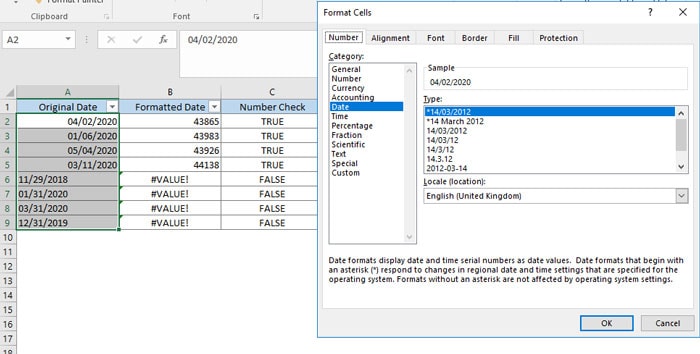The Facts About Excel Links Not Working Revealed
Wiki Article
A Biased View of Excel Links Not Working
Table of ContentsWhat Does Excel Links Not Working Mean?3 Easy Facts About Excel Links Not Working DescribedThe Definitive Guide for Excel Links Not WorkingThe Best Guide To Excel Links Not WorkingThe 4-Minute Rule for Excel Links Not Working

Range calculation features like either can not manage entire column references or determine all the cells in the column. User-defined features don't automatically recognize the last-used row in the column as well as, for that reason, often determine entire column recommendations inefficiently. It is very easy to program user-defined functions so that they identify the last-used row.

About Excel Links Not Working
Using the formula for a dynamic array is typically preferable to the formula because has the negative aspect of being an unpredictable function that will certainly be computed at every recalculation. Efficiency lowers because the feature inside the vibrant variety formula must check out many rows. You can minimize this efficiency decrease by storing the part of the formula in a separate cell or specified name, and afterwards referring to the cell or name in the vibrant array: Counts!z1=COUNTA(Sheet1!$A:$A) Offset, Dynamic, Array=OFFSET(Sheet1!$A$ 1,0,0, Counts!$Z$ 1,1) Index, Dynamic, Range=Sheet1!$A$ 1: INDEX(Sheet1!$A:$A, Counts!$Z$ 1+ROW(Sheet1!$A$ 1) - 1,1) You can likewise use features such as to construct dynamic varieties, yet is unpredictable as well as constantly determines single-threaded.
Using several dynamic varieties within a solitary column calls for special-purpose counting features. Utilizing lots of vibrant ranges can decrease performance. In Office 365 variation 1809 as well as later, Excel's VLOOKUP, HLOOKUP, and suit for precise suit on unsorted information is much faster than in the past when searching for several columns (or rows with HLOOKUP) from the very same table array.
Fortunately, there are several ways of boosting lookup computation time - excel links not working. If you utilize the specific suit choice, the computation time for the feature is proportional to the number of cells checked prior to a match is found. For lookups over big ranges, this time around can be substantial. Lookup time utilizing the approximate match options of,, as well as on arranged information is quick and also is not significantly enhanced by the length of the range you are seeking out.
Some Known Details About Excel Links Not Working
Ensure that you comprehend the match-type as well as range-lookup choices in,, and also. The complying with code instance reveals the syntax for the feature. MATCH(lookup worth, lookup variety, matchtype) returns the largest suit much less than or equal to the lookup value when the lookup selection is sorted rising (approximate match).The default choice is approximate suit arranged ascending. requests a specific suit and presumes that the information is not sorted. returns the tiniest match more than or equal to the my website lookup value if the lookup range is arranged coming down (approximate suit). The complying with code example reveals the syntax for the and also functions.
VLOOKUP(lookup worth, table selection, col index num, range-lookup) HLOOKUP(lookup worth, table array, row index num, range-lookup) returns the biggest suit much less than or equal to the lookup value (approximate suit). This is the default alternative. Table array should be arranged ascending. requests a specific suit as well as thinks the data is not arranged.
The Best Strategy To Use For Excel Links Not Working
If your information is arranged, but you desire an exact suit, see Usage two lookups for sorted information with missing out on values. Attempt utilizing the and works instead of. Although is a little faster (around 5 percent faster), simpler, as well as utilizes less memory than a combination of as well as, or, the additional flexibility that and offer typically enables you to substantially save time.
The feature is rapid and is a non-volatile feature, which quickens recalculation. The feature is additionally quickly; nevertheless, it is a volatile feature, and also it in some cases dramatically increases the moment taken to process the computation chain. It's simple to convert to as well as. The following two declarations return the exact same answer: VLOOKUP(A1, Information!$A$ 2:$F$ 1000,3, False) INDEX(Data!$A$ 2:$F$ 1000, SUIT(A1,$A$ 1:$A$ 1000,0),3) Due to the fact that exact suit lookups can be slow, take into consideration the adhering to options for improving efficiency: Use one worksheet.
When you can, the data first (is rapid), and also use approximate match. When you need to make use of a specific suit lookup, limit the range of cells to be scanned to a minimum. Use tables as well as structured referrals or vibrant variety names rather than referring to a a great deal of rows or columns.
Fascination About Excel Links Not Working
Two approximate matches are significantly faster than one precise suit for a lookup over more than a couple of rows. (The breakeven point is concerning 10-20 rows.) If you can sort your information but still can not make use of approximate match because you can not be sure that the her explanation value you are searching for exists in the lookup variety, you can use this formula: IF(VLOOKUP(lookup_val, lookup_array,1, True)=lookup_val, _ VLOOKUP(lookup_val, lookup_array, column, True), "notexist") The first part of the formula functions by doing an approximate lookup on the lookup column itself.VLOOKUP(lookup_val, lookup_array, column, True) If the answer from the lookup column did not match the lookup worth, you have a missing value, and the formula returns "notexist". Understand that if you look up a worth smaller sized than the smallest worth in the listing, you get an error. You can handle this mistake by utilizing, or by adding a tiny test worth to the checklist.
Beginning with Excel 2007, you can make use of the feature, which is both easy and rapid. IF IFERROR(VLOOKUP(lookupval, table, 2 FALSE),0) In earlier versions, an easy however slow-moving method is to use a feature that includes two lookups. IF(ISNA(VLOOKUP(lookupval, table,2, FALSE)),0, _ VLOOKUP(lookupval, table,2, FALSE)) You can prevent additional resources the double precise lookup if you use specific once, store the cause a cell, as well as after that examine the result before doing an.
Report this wiki page